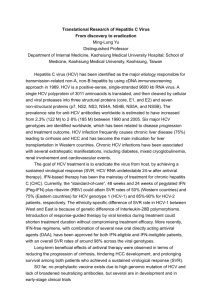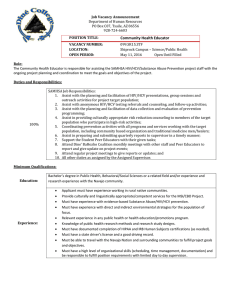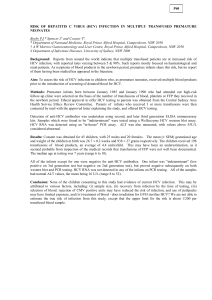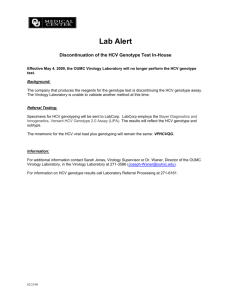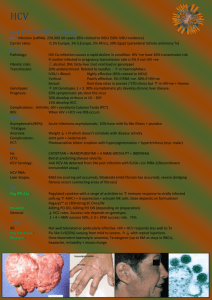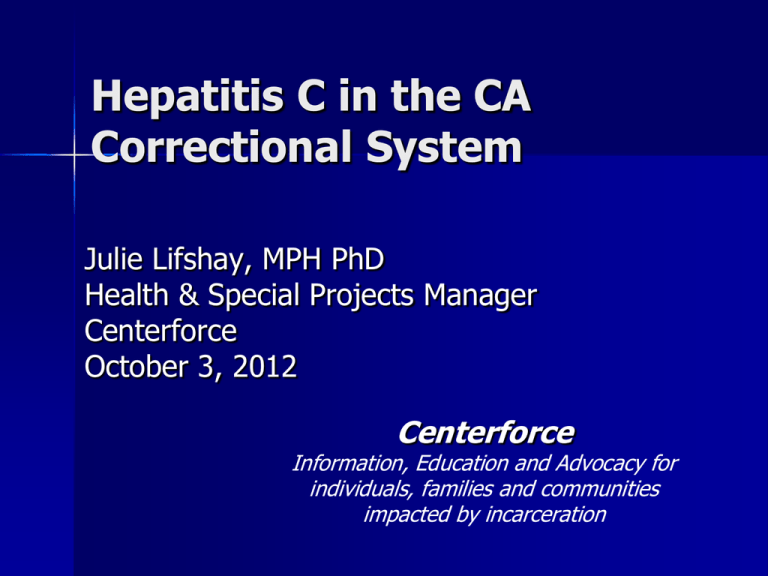
Hepatitis C in the CA
Correctional System
Julie Lifshay, MPH PhD
Health & Special Projects Manager
Centerforce
October 3, 2012
Centerforce
Information, Education and Advocacy for
individuals, families and communities
impacted by incarceration
Rates of HCV testing
in incarcerated settings
1999-2000
In the U.S. as a whole:
– 7.9%
In California:
– 11.7%
© Centerforce 2012
2
Prevalence of HCV
Among People who are incarcerated
In the United States as a whole:
– 31%*
*OF THOSE TESTED
~26.5% of HCV+ treated
In California:
– 41% (39.4% for men, 53.5% for women)**
**Upon entry
© Centerforce 2012
3
Hep C in the incarcerated
in CA
133,261 adults currently living in state
prison in CA*
– ~5% (6,071) are women
4,503 women in Chowchilla
Estimated 54,637 currently living with
Hep C
1999-2000**: CA treated 2,024 people in
prison for Hep C = 40% of whole U.S.
© Centerforce 2012
4
Cost of Hep C in the incarcerated in CA
In 2011, Liver Disease was the 2nd
Leading Cause of Death in CDCR*
– 19.6% of deaths overall (n = 76)
Cost: Approximately $5,000 to treat Hep
C in CDCR system**
Cost for latest type 1 treatment is ~ $65,000 per
patient**
Hep C tx is cost-effective***
© Centerforce 2012
5
Paroled in CA
2009: ~77.6% (n = 130,182)
2010: ~76% (n = 122,741)
2011: ~61% (n = 97,675)
– ~~40,047 with Hep C
– 4.4% (n = 4,298) to Fresno or Madera
~~1,762 with Hep C
© Centerforce 2012
6
Parolees in CA (2012)
28.8% African American
36.2% Hispanic
61.7% less than 40 years old
92.6% men
© Centerforce 2012
7
HCV-related risk behaviors on
outside
70-83% of people in state prisons
report a past hx of drug use
45-57% report IVDU in month before
incarceration
75% of IDUs spend some time in
correctional facilities
© Centerforce 2012
HCV-related risk behaviors inside
Injection Drug Use
– Estimates of IDU use inside range from 3-28%
among adults
Tattooing inside common
– 36.5% report tattooing from Ohio study*
– Risk for HCV approx 3X greater among those who
get tattoos inside**
Two studies of HCV incidence have found
rates of 0.4-1.1 infections per 100 person years
of incarceration among men
© Centerforce 2012
HIV-related risk behaviors
inside
Male-male sex
– 84% of incarcerated population is male
– Estimates of male inmates who have had sex (oral
or anal) with other male inmates range from 4-30%
– Project START found that 17% had had sex while
confined
© Centerforce 2012
HIV-related risk behaviors
inside
Rape and sexual assault
– Prison Rape Reduction Act of 2002 states that
13.6% of individuals sexually attacked at least
once during incarceration
– In 2005, there were 2.83 allegations of sexual
violence per 1,000 inmates held in prisons, jails,
and other adult correctional facilities
38% involved staff sexual misconduct, 35% inmateinmate nonconsensual sex
© Centerforce 2012
The Case for HCV prevention
in prisons
Most return to the community
1/3 with HCV pass through
correctional system annually
Initial & most consistent contact with
healthcare system
Primary, secondary, & tertiary
prevention
© Centerforce 2012
Components of an HCV
Prevention Program in
Incarcerated Setting
Screening
Treatment
Harm Reduction
Education
Transitional Care
© Centerforce 2012
13
Challenges Faced by
People Inside
Disconnection from loved ones
Educational levels
Past Experiences of violence
Emotional growth
Drug Addiction
Prison culture
Loss of Hope
Loss of Motivation
Job skills and opportunities
Prevalent and Incident Health issues
© Centerforce 2012
HCV prevention interventions
for people who are incarcerated
Harm reduction: Needle exchange
– WHO and UNAIDS recommends that prisoners have
access to bleach and that needle-exchange programs be
considered
– Evaluation of programs providing sterile needles and
syringes in 3 European countries*:
No increase in drug use
A dramatic decrease in needle sharing
No new cases of HIV or Hep B or C
No reported instances of needles being used as weapons
– No US prison has a needle-exchange program
© Centerforce 2012
HCV prevention interventions
for people who are incarcerated
Harm reduction: Methadone Treatment
– WHO and UNAIDS recommends that prisoners
have access to methadone maintenance programs
– 70-85% of inmates need some level of substance
abuse treatment and yet only 10% receive
treatment during incarceration
– 2003 study:
48% of US prison systems provide methadone treatment, largely
for pregnant inmates or short-term detox
Only 8% refer opiate-dependent inmates to methadone programs
upon release
© Centerforce 2012
HCV prevention interventions
for people who are
incarcerated
Harm reduction: condoms
– WHO and UNAIDS have recommended the
distribution of condoms to prisoners since 1993
– 48/50 state prison systems and all but 5 jails
consider condoms to be contraband (Vermont, MS,
NYC, Philadelphia, LA, SF, and DC)
– Only two US systems distribute dental dams and
condoms to female inmates
© Centerforce 2012
HCV prevention education
What:
–Educational Materials (e.g.
posters, brochures)
–1 hour educational
presentations
–Education/support for HCV+
–1:1 conversation
–Video / DVD
© Centerforce 2012
HCV prevention education
Who:
– Medical and/or CO speaker
– Community speaker
– Peer Educator (i.e., fellow prisoners)
Trusted
Credibility
Language/Terminology
Behaviors
Motivations
Timing
Creates
a community of knowledge
© Centerforce 2012
Transitional Care
Effective community re-entry support is vital for
continuity of care post-release
Re-entry/transitional and community health
programs serving this community must
communicate effectively to successfully support
client needs
Case management may be particularly useful in
helping high-risk clients engage in health-seeking
behaviors (e.g. accessing primary care and
substance abuse treatment services)
© Centerforce 2012
20
Re-entry Success
Strong predictors of post-release care
utilization & not recidivating include
– housing stability
– housing comfort
– no alcohol use
– Drug treatment
– Food
© Centerforce 2012
21
Re-entry Success
For Disease Prevention as well as overall
success, programs should also support
Partner/Family Communication re:
– Risks of infection
– Testing
– Prevention
– Treatment
– Decision making
– Support and planning for success
© Centerforce 2012
22
Contact Info
www.centerforce.org
Julie Lifshay
jlifshay@centerforce.org
415-456-9980 ext. 205
© Centerforce 2012


